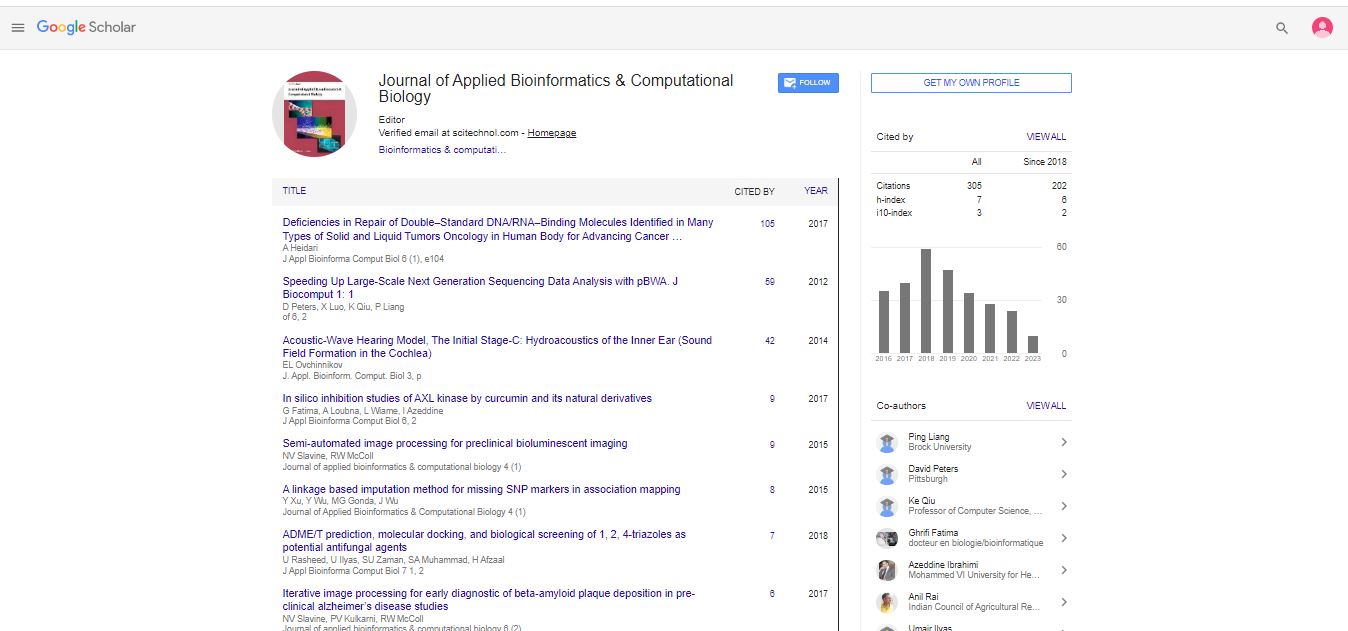Perspective, J Appl Bioinforma Comput Bio Vol: 14 Issue: 1
The Genomic Landscape Consider the Depths of Genetic Codes and Beyond
Amelie Valanciute*
Department of Biotechnology, Rama University, Kanpur, India
*Corresponding Author: Amelie Valanciute,
Department of Animal Biotechnology, Rama University, Kanpur, India
E-mail: valanciutea89@gmail.com
Received date: 20 February, 2024, Manuscript No. JABCB-24-127921;
Editor assigned date: 22 February, 2024, PreQC No. JABCB-24-127921 (PQ);
Reviewed date: 04 March, 2024, QC No. JABCB-24-127921;
Revised date: 22 April, 2025, Manuscript No. JABCB-24-127921 (R);
Published date: 29 April, 2025, DOI: 10.4172/2329-9533.1000294
Citation: Valanciute A (2025) The Genomic Landscape Consider the Depths of Genetic Codes and Beyond. J Appl Bioinforma Comput Biol 14:1.
Introduction
Genomics, a burgeoning field at the intersection of biology and technology, delves into the comprehensive study of nucleotide sequences encapsulated within the chromosomes of organisms. It encompasses not only the structural genes that encode proteins but also regulatory sequences and noncoding DNA segments, collectively shaping the blueprint of life itself.
Description
The genomic framework
At the heart of genomics lies the understanding of genomes, the complete set of an organism's genetic material. With advances in sequencing technologies, scientists can now decipher these intricate codes with unprecedented precision and speed. From the humble beginnings of Sanger sequencing to the high-throughput capabilities of Next-Generation Sequencing (NGS), the genomic toolkit has evolved exponentially, revolutionizing our comprehension of genetic complexity.
Structural genes
Central to the genomic narrative are structural genes, which encode the proteins responsible for executing various cellular functions. Through the lens of genomics, researchers scrutinize these genes, deciphering their sequences, identifying mutations, and elucidating their roles in health and disease. From the robust cataloging of human genes in the Human Genome Project (HGP) to the ongoing exploration of genetic diversity across species, structural genomics continues to unravel the intricacies of life's building blocks.
Regulatory sequences
Beyond the realm of structural genes lie regulatory sequences, the orchestrators of gene expression. These non-coding regions, once dismissed as genetic "junk," are now recognized as pivotal players in the fine-tuned regulation of cellular processes. Through genomic analyses, researchers decipher the language of regulatory elements, unveiling their roles in modulating gene activity, responding to environmental cues, and maintaining cellular homeostasis.
Noncoding DNA segments
Among the vast expanse of genomic sequences, noncoding DNA segments stand out as enigmatic entities. Traditionally relegated to the sidelines, these regions defy conventional wisdom by harboring hidden regulatory motifs, structural elements, and evolutionary signatures. Genomic investigations into noncoding DNA unveil their cryptic roles in genome organization, epigenetic regulation, and species diversification, underscoring the rich tapestry of genetic information beyond protein-coding regions.
Applications of genomics
The insights gleaned from genomic research reverberate across diverse domains, from medicine and agriculture to conservation and beyond. In healthcare, genomics underpins precision medicine initiatives, guiding tailored interventions based on individual genetic profiles. In agriculture, genomic tools empower crop breeding programs, enhancing yield, resilience, and nutritional content. In conservation biology, genomics informs strategies for preserving endangered species, unraveling their genetic heritage and facilitating targeted conservation efforts.
Challenges and future directions
Despite its transformative potential, genomics grapples with formidable challenges, from computational complexities to ethical dilemmas. The deluge of genomic data necessitates robust bioinformatics infrastructure and analytical frameworks to extract meaningful insights. Moreover, ethical considerations surrounding genomic privacy, data sharing, and equitable access underscore the need for conscientious governance and stakeholder engagement.
Looking ahead, the future of genomics brims with promise and possibility. Emerging technologies such as single-cell sequencing, long-read sequencing, and genome editing hold the keys to unlocking new frontiers in genomic research. As genomics continues to unravel the intricacies of genetic codes, its impact on human health, agriculture, biodiversity conservation, and beyond will be profound, reshaping our understanding of life's fundamental principles.
Conclusion
In the grand tapestry of life, genomics serves as a powerful lens, illuminating the intricate threads of genetic inheritance that weave through every living organism. From the humble beginnings of nucleotide sequencing to the present-day genomic revolution, the journey of genomics exemplifies humanity's quest to unravel the mysteries of life itself. As we stand on the cusp of a genomic renaissance, poised to explore the depths of genetic codes and beyond, the promise of genomics beckons us toward a future brimming with discovery, innovation, and transformative impact.
 Spanish
Spanish  Chinese
Chinese  Russian
Russian  German
German  French
French  Japanese
Japanese  Portuguese
Portuguese  Hindi
Hindi 
